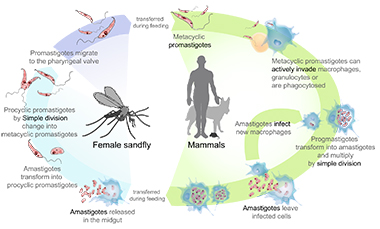|
Leishmaniasis is one of the neglected diseases in the world caused by a protozoan parasite (leishmania) and transmitted by sandfly. It is found widely spread in almost hundred countries in the world. It can exist clinically as visceral, cutaneous and mucocutaneous forms, the visceral form being fatal unless treated. Confirmatory diagnosis is by demonstration of the parasite from tissue aspirates (spleen, bone marrow, lymph node, skin lesion). Molecular diagnositics using PCR are commonly used in developed countries. Serological tests have variable diagnostic yield from region to region. A few drugs are available to treat leishmaniasis – antimonials (sodium stibogluconate, glucantime), liposomal amphotericin B, miltefosine and paromomycin. There is no protective vaccine for travelers. There are no unique and standard vector control means identified for sand fly control to date.
All forms of leishmaniasis exist in Ethiopia. Visceral leishmaniasis is endemic in the low land and arid places especially Northwest and Southwest regions of the country with an annual burden ranging from 2000 to 4500. The incidence varies from year to year due to seasonal outbreaks. The cutaneous forms are found rather widely distributed, mainly in the highland regions. The annual estimates reach from 20,000 to 40,000.
A lot of efforts are put to prevent and control leishmaniasis in Ethiopia. There is a Neglected Tropical Diseases Unit within the Disease Prevention Control Directorate in the Federal Ministry of Health. The program is also cascaded to the regions where the disease is endemic. National Guidelines for treatment and prevention of leishmaniasis have been prepared and distributed. This training manual for health care providers is also part of the strategies for the control of the diseases. It will be used in the skilled health manpower development. The content of the manual is prepared based on the existing guidelines and the research experiences in the country.
|
 |